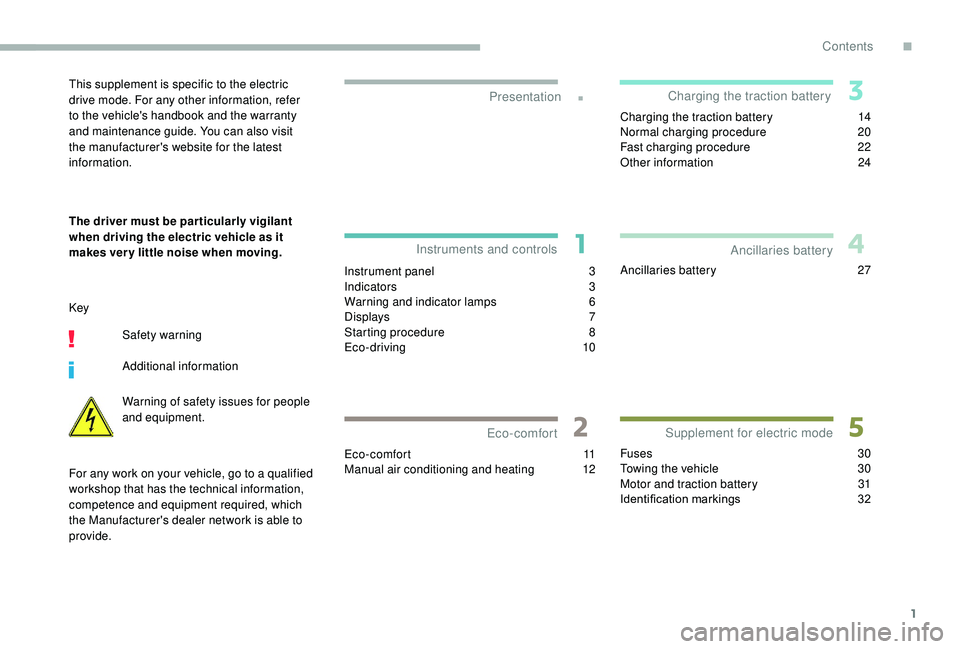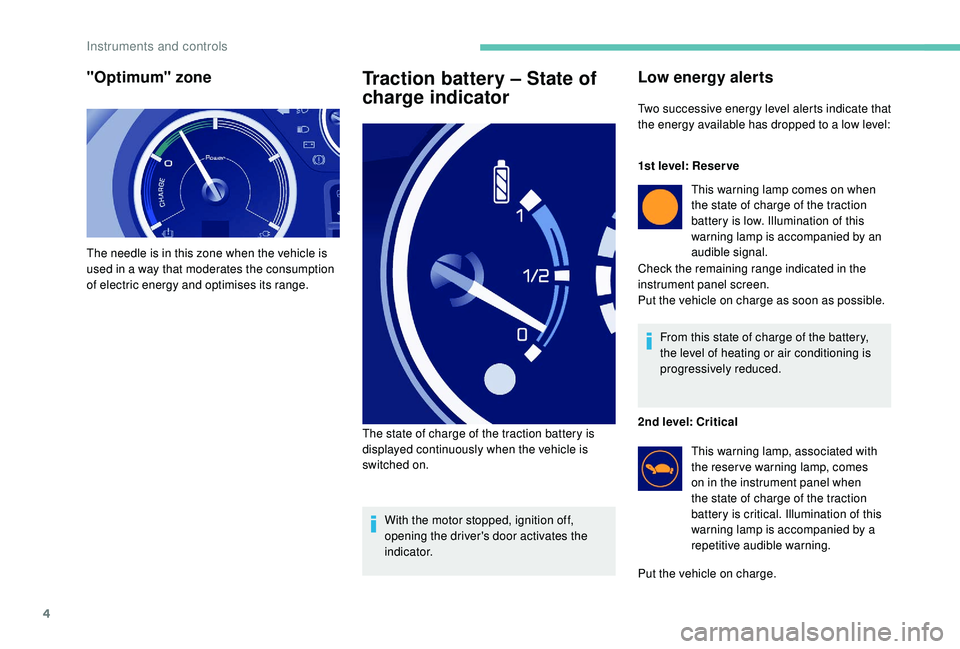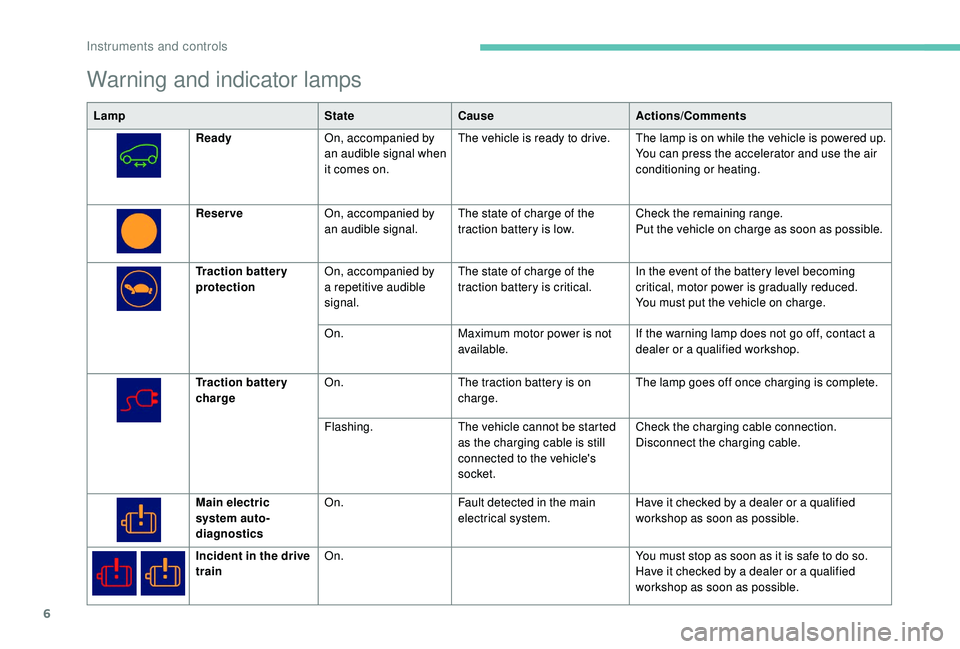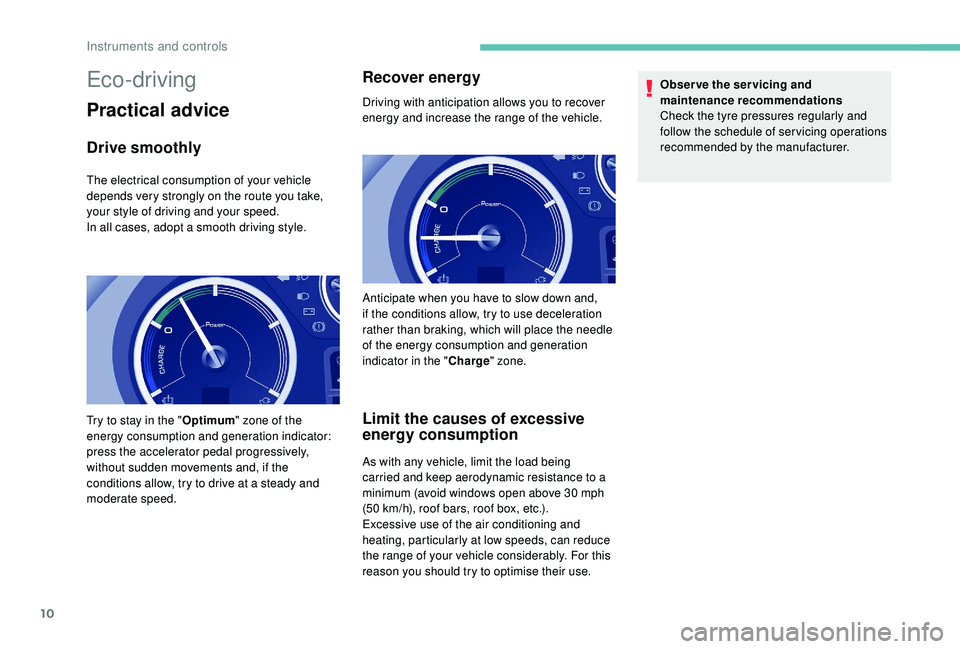Page 3 of 252

1
.
Instrument panel 3
I ndicators 3
Warning and indicator lamps
6
D
isplays
7
Starting procedure
8
E
co-driving
10
Eco-comfort
11
Manual air conditioning and heating
1
2Charging the traction battery
1
4
Normal charging procedure
2
0
Fast charging procedure
2
2
Other information
2
4
Ancillaries battery 2 7
Fuses
30
Towing the vehicle
3
0
Motor and traction battery
3
1
Identification markings
3
2
Presentation
Instruments and controls
Eco-comfort Charging the traction battery
Supplement for electric mode Ancillaries batteryThis supplement is specific to the electric
drive mode. For any other information, refer
to the vehicle's handbook and the warranty
and maintenance guide. You can also visit
the manufacturer's website for the latest
information.
The driver must be par ticularly vigilant
when driving the electric vehicle as it
makes ver y little noise when moving.
Key
Safety warning
Additional information
Warning of safety issues for people
and equipment.
For any work on your vehicle, go to a qualified
workshop that has the technical information,
competence and equipment required, which
the Manufacturer's dealer network is able to
provide.
Contents
.
Contents
Page 5 of 252

3
Instrument panel
1.Current energy consumption and
generation indicator
2. Traction battery state of charge indicator
3. Heating and air conditioning systems
energy consumption indicator
4. Ready lamp
5. Estimated remaining range
6. Drive selector position
7. Warning lamps specific to the electric
motor
Indicators
Traction battery – Energy
consumption and
generation indicator
Neutral position
With the motor stopped and the ignition
off, opening the driver's door activates the
energy indicator, which places itself in the
"neutral" position.
Energy consumption
"Charge" zone
On switching on the ignition, your vehicle
neither consumes nor generates energy
through its electric drive train: after sweeping
over its range, the needle settles in the
"neutral" position. The needle moves to the right, in proportion to
the consumption of energy by the drive train.
The needle moves to the left, in proportion
to the level of charge going into the traction
battery, during periods of deceleration and
braking.
1
Instruments and controls
Page 6 of 252

4
"Optimum" zone
The needle is in this zone when the vehicle is
used in a way that moderates the consumption
of electric energy and optimises its range.
Traction battery – State of
charge indicator
With the motor stopped, ignition off,
opening the driver's door activates the
i n d i c a t o r.
The state of charge of the traction battery is
displayed continuously when the vehicle is
switched on.
Low energy alerts
Two successive energy level alerts indicate that
the energy available has dropped to a low level:
1st level: Reser ve
This warning lamp comes on when
the state of charge of the traction
battery is low. Illumination of this
warning lamp is accompanied by an
audible signal.
Check the remaining range indicated in the
instrument panel screen.
Put the vehicle on charge as soon as possible.
From this state of charge of the battery,
the level of heating or air conditioning is
progressively reduced.
2nd level: Critical This warning lamp, associated with
the reser ve warning lamp, comes
on in the instrument panel when
the state of charge of the traction
battery is critical. Illumination of this
warning lamp is accompanied by a
repetitive audible warning.
Put the vehicle on charge.
Instruments and controls
Page 7 of 252
5
The remaining range is no longer
calculated. The power of the drive train is
progressively reduced.
The heating and air conditioning are
stopped (even if the needle that indicates
consumption is not in ECO m o d e).Heating and air
conditioning systems
energy consumption
indicatorExcessive use, particularly at low speeds,
can reduce the range of your vehicle
considerably.
Remember to optimise their use and
check their settings at each start so as to
maximise the range of the vehicle.
This gauge represents the consumption of
electrical energy related to the heating and air
conditioning.
1
Instruments and controls
Page 8 of 252

6
Warning and indicator lamps
LampStateCause Actions/Comments
Ready On, accompanied by
an audible signal when
it comes on. The vehicle is ready to drive. The lamp is on while the vehicle is powered up.
You can press the accelerator and use the air
conditioning or heating.
Reser ve On, accompanied by
an audible signal. The state of charge of the
traction battery is low. Check the remaining range.
Put the vehicle on charge as soon as possible.
Traction battery
protection On, accompanied by
a repetitive audible
signal. The state of charge of the
traction battery is critical.
In the event of the battery level becoming
critical, motor power is gradually reduced.
You must put the vehicle on charge.
On. Maximum motor power is not
available. If the warning lamp does not go off, contact a
dealer or a qualified workshop.
Traction battery
charge On.
The traction battery is on
charge. The lamp goes off once charging is complete.
Flashing. The vehicle cannot be started
as the charging cable is still
connected to the vehicle's
socket. Check the charging cable connection.
Disconnect the charging cable.
Main electric
system auto-
diagnostics On.
Fault detected in the main
electrical system. Have it checked by a dealer or a qualified
workshop as soon as possible.
Incident in the drive
train On.
You must stop as soon as it is safe to do so.
Have it checked by a dealer or a qualified
workshop as soon as possible.
Instruments and controls
Page 9 of 252
7
Displays
Screen (depending on
equipment level)
Setting the units
Range
Each press of the button on the end of the
windscreen wiper stalk allows you to scroll
through the various trip computer information
displays, depending on the screen. The screen shows:
-
t
he estimated range remaining,
-
t
he additional range available by using
the ECO mode on the heating and air
conditioning control panel,
With navigation, the driving range area is
displayed on the map.
1
Instruments and controls
Page 12 of 252

10
Eco-driving
Practical advice
Drive smoothly
The electrical consumption of your vehicle
depends very strongly on the route you take,
your style of driving and your speed.
In all cases, adopt a smooth driving style.
Recover energy
Driving with anticipation allows you to recover
energy and increase the range of the vehicle.
Limit the causes of excessive
energy consumption
As with any vehicle, limit the load being
carried and keep aerodynamic resistance to a
minimum (avoid windows open above 30 mph
(50 km/h), roof bars, roof box, etc.).
Excessive use of the air conditioning and
heating, particularly at low speeds, can reduce
the range of your vehicle considerably. For this
reason you should try to optimise their use.Obser ve the ser vicing and
maintenance recommendations
Check the tyre pressures regularly and
follow the schedule of ser vicing operations
recommended by the manufacturer.
Try to stay in the " Optimum" zone of the
energy consumption and generation indicator:
press the accelerator pedal progressively,
without sudden movements and, if the
conditions allow, try to drive at a steady and
moderate speed. Anticipate when you have to slow down and,
if the conditions allow, try to use deceleration
rather than braking, which will place the needle
of the energy consumption and generation
indicator in the "
Charge" zone.
Instruments and controls
Page 13 of 252
11
Eco-comfort
Pressing the ECO button stops the
heating and air conditioning (but maintains
ventilation). The needle of the energy
consumption and generation indicator is
placed in the ECO zone. Stops the heating or air conditioning
and maintains ventilation.
Stops the heating or air conditioning
and ventilation.
Operating the temperature
control activates the heating or air
conditioning and stops ECO mode.
Control the use of your
electrical equipment
The heating and air conditioning operate using
energy supplied by the traction battery. Their
excessive use significantly reduces the range
of your vehicle. Try to optimise their use as
soon as you have reached the desired level of
comfort and check the settings at every start
in order to maximise range. Also limit the use
of demisting and defrosting and of the heated
seat.
2
Eco-comfort